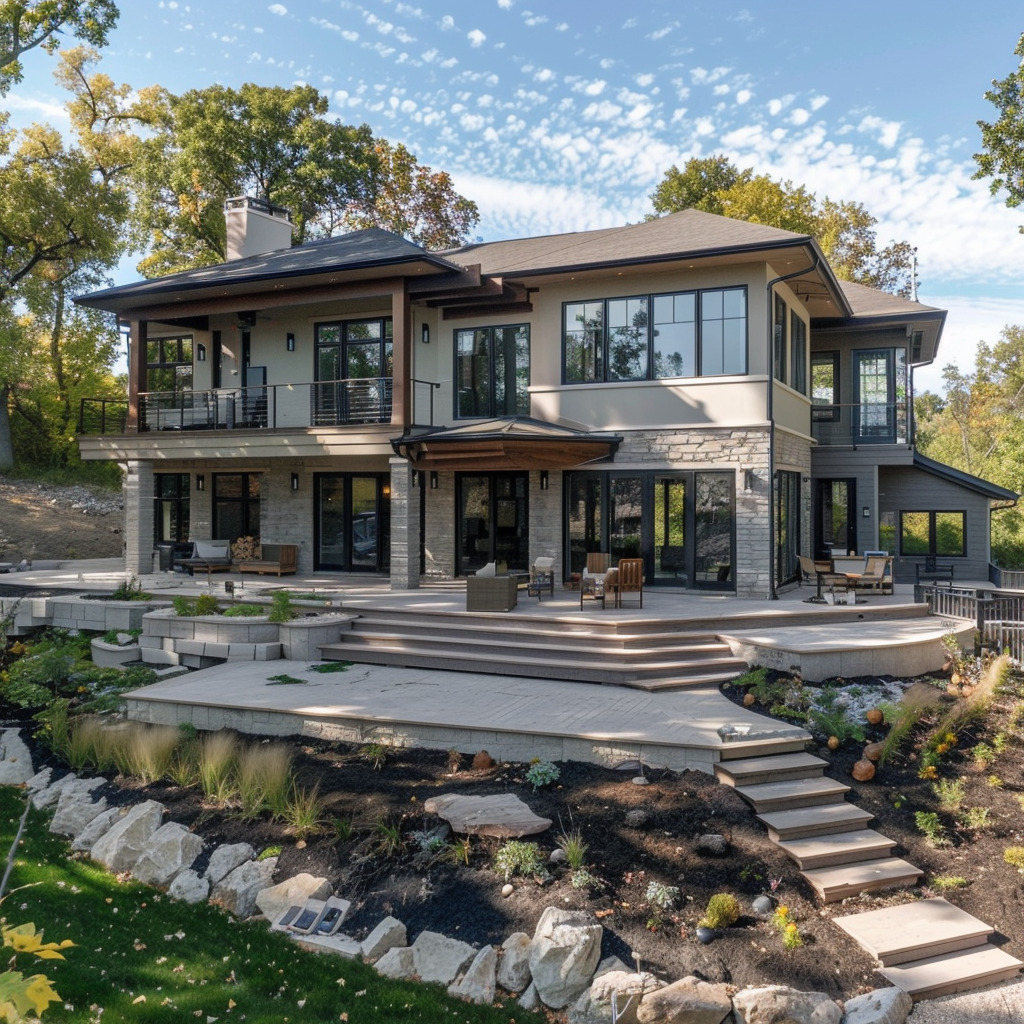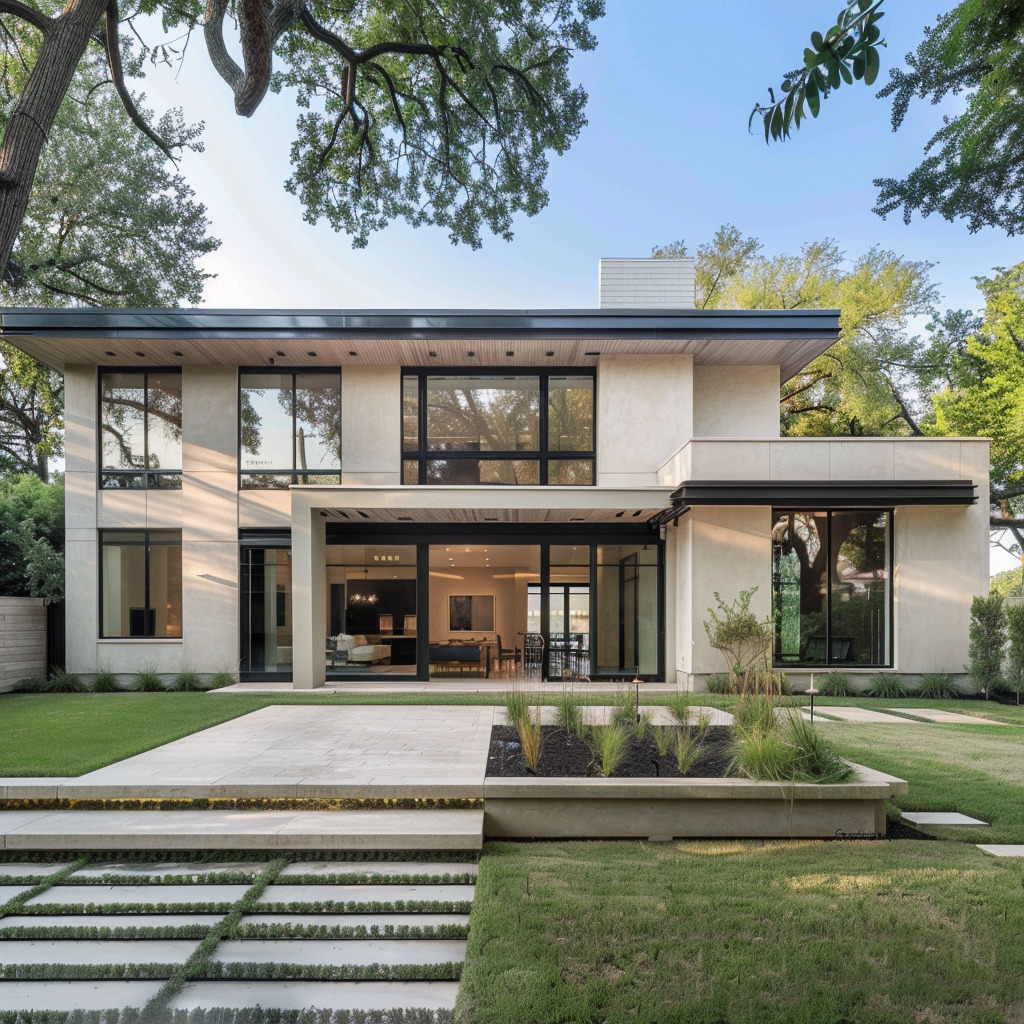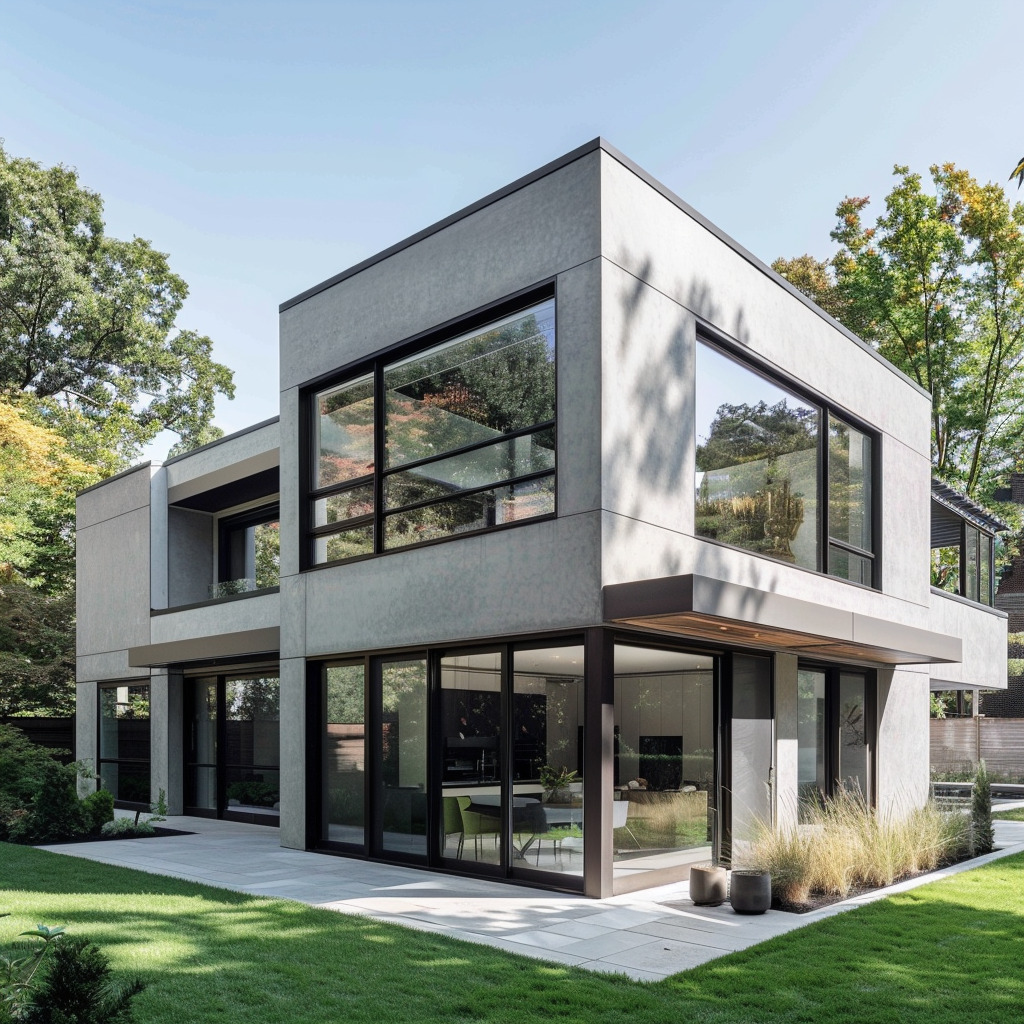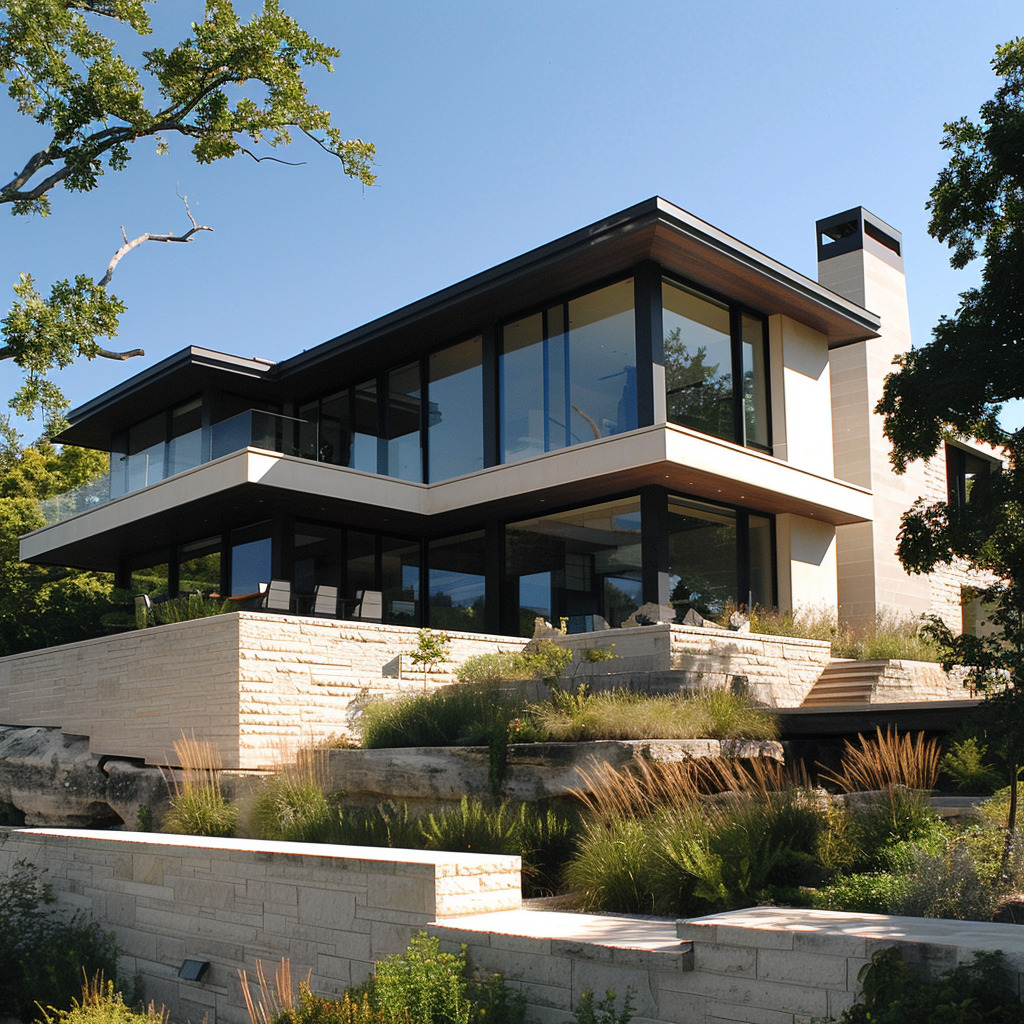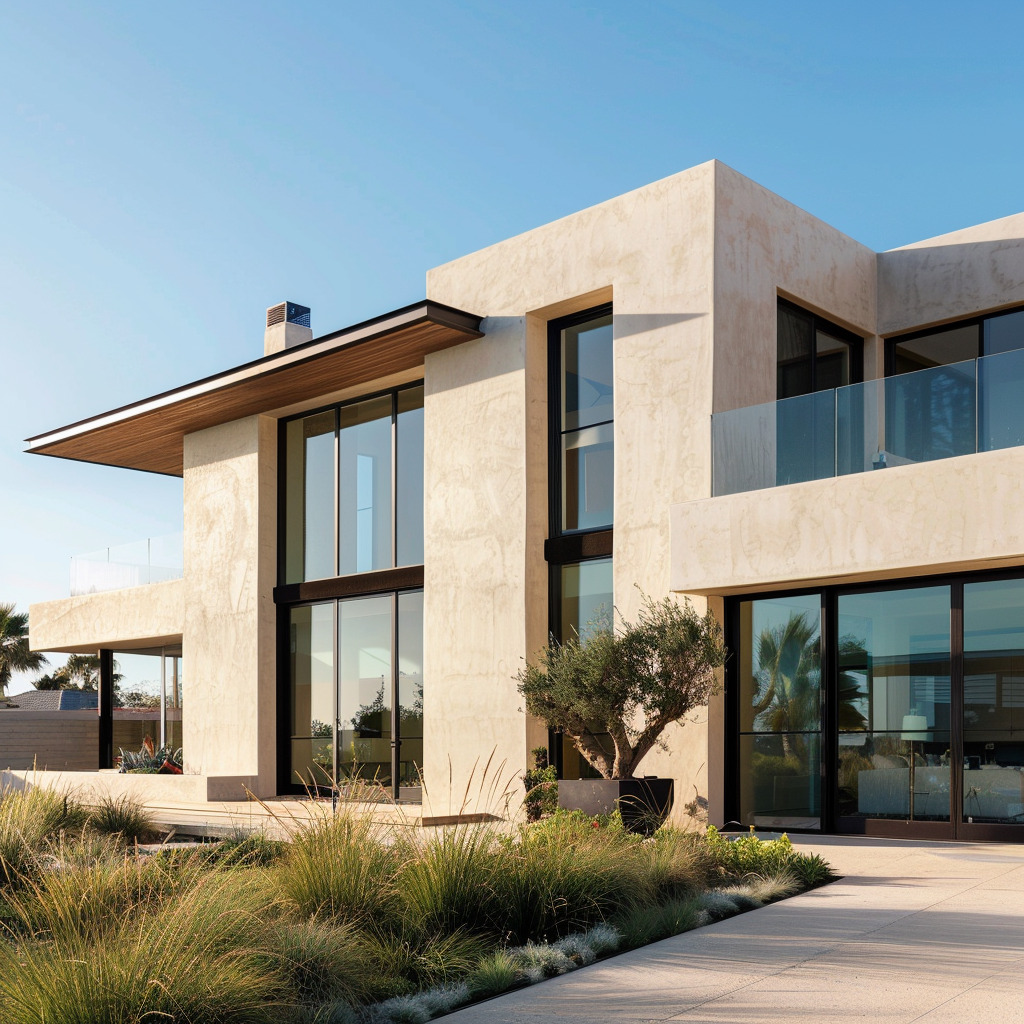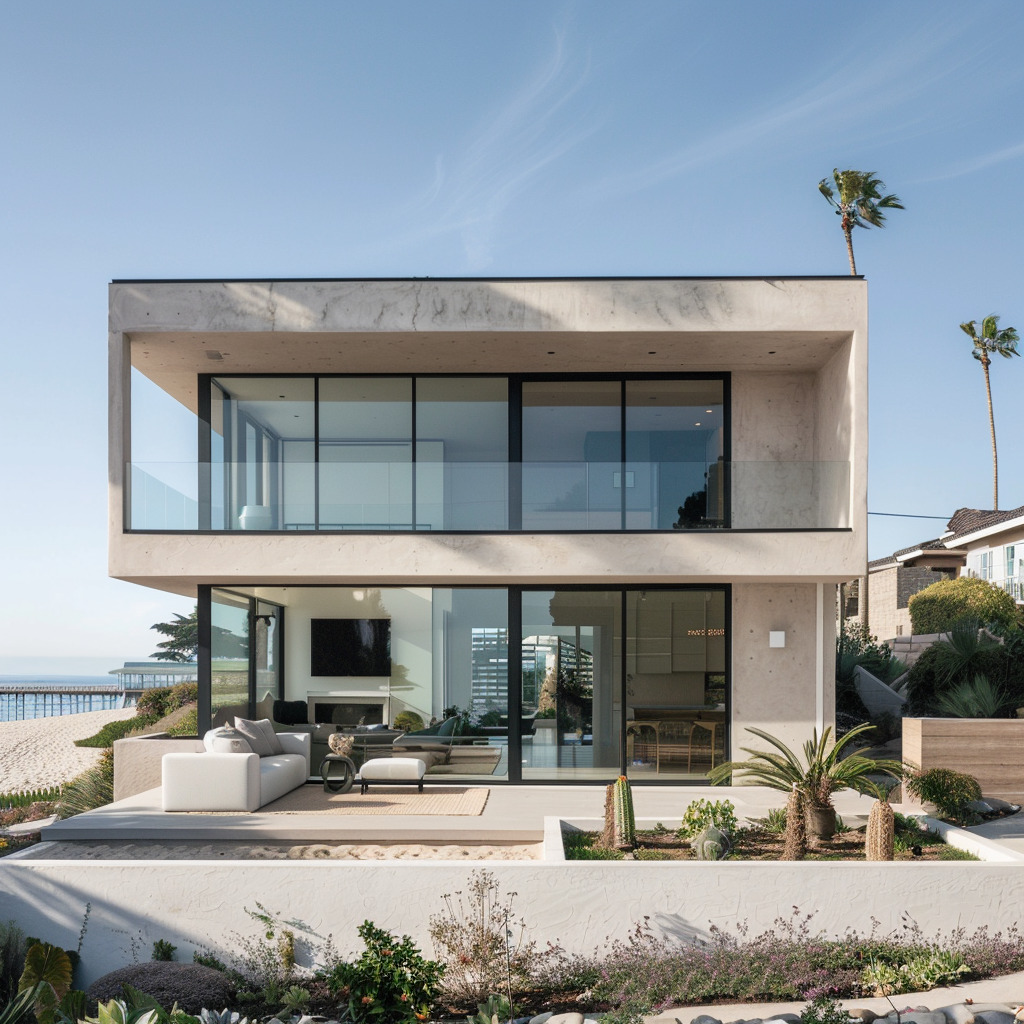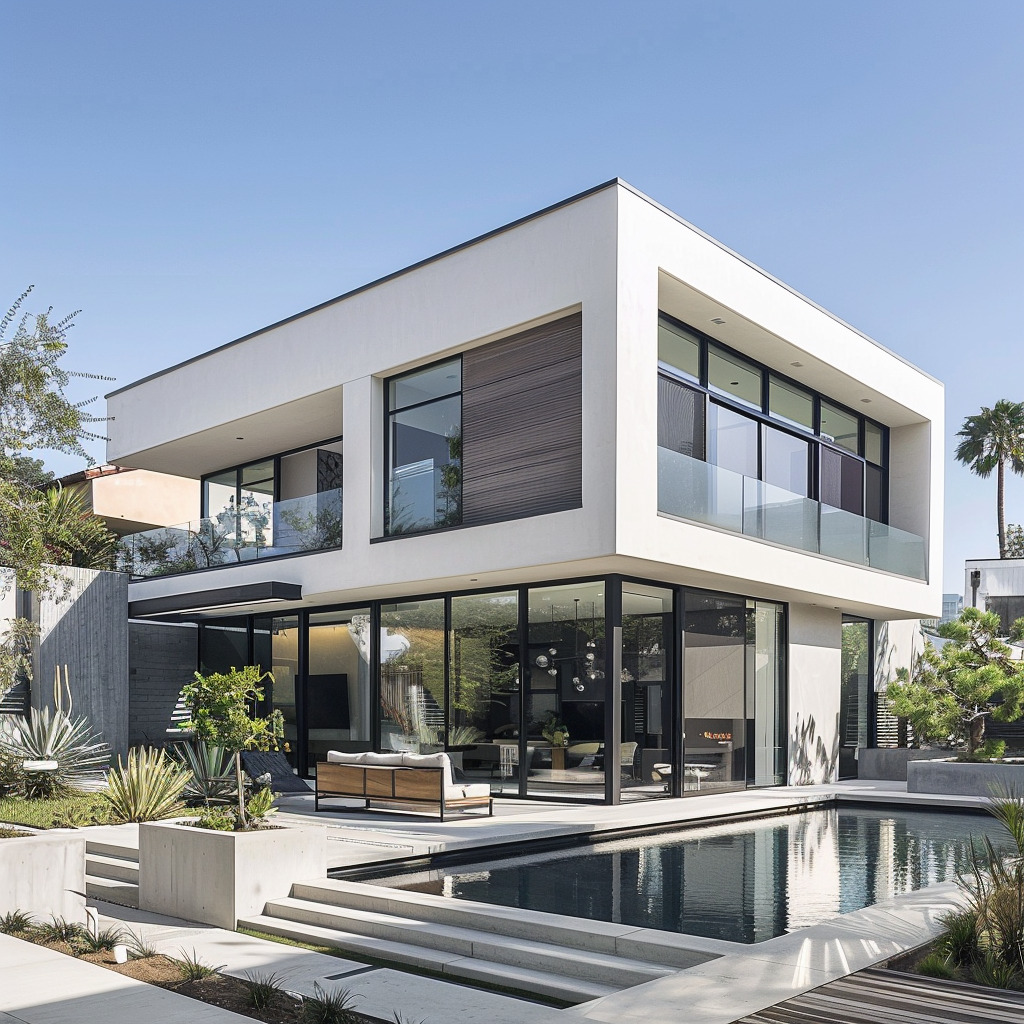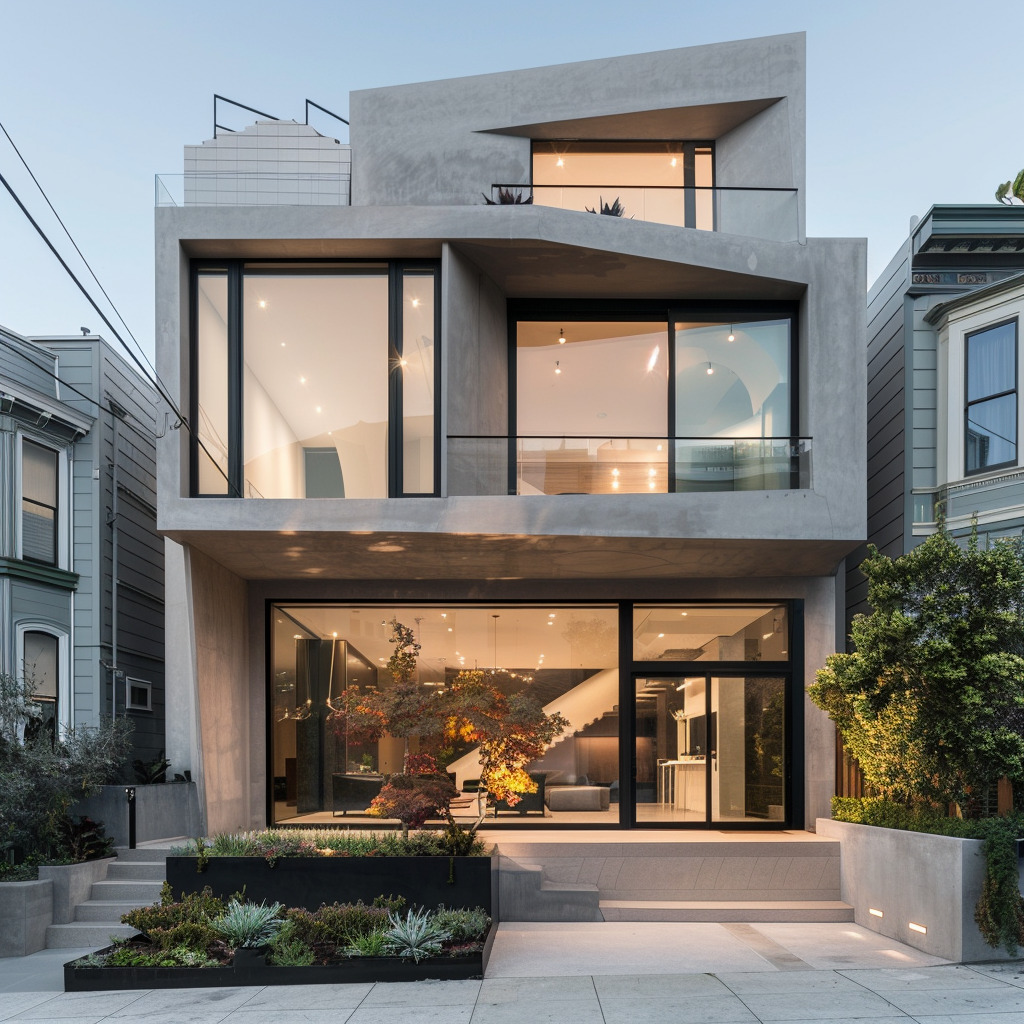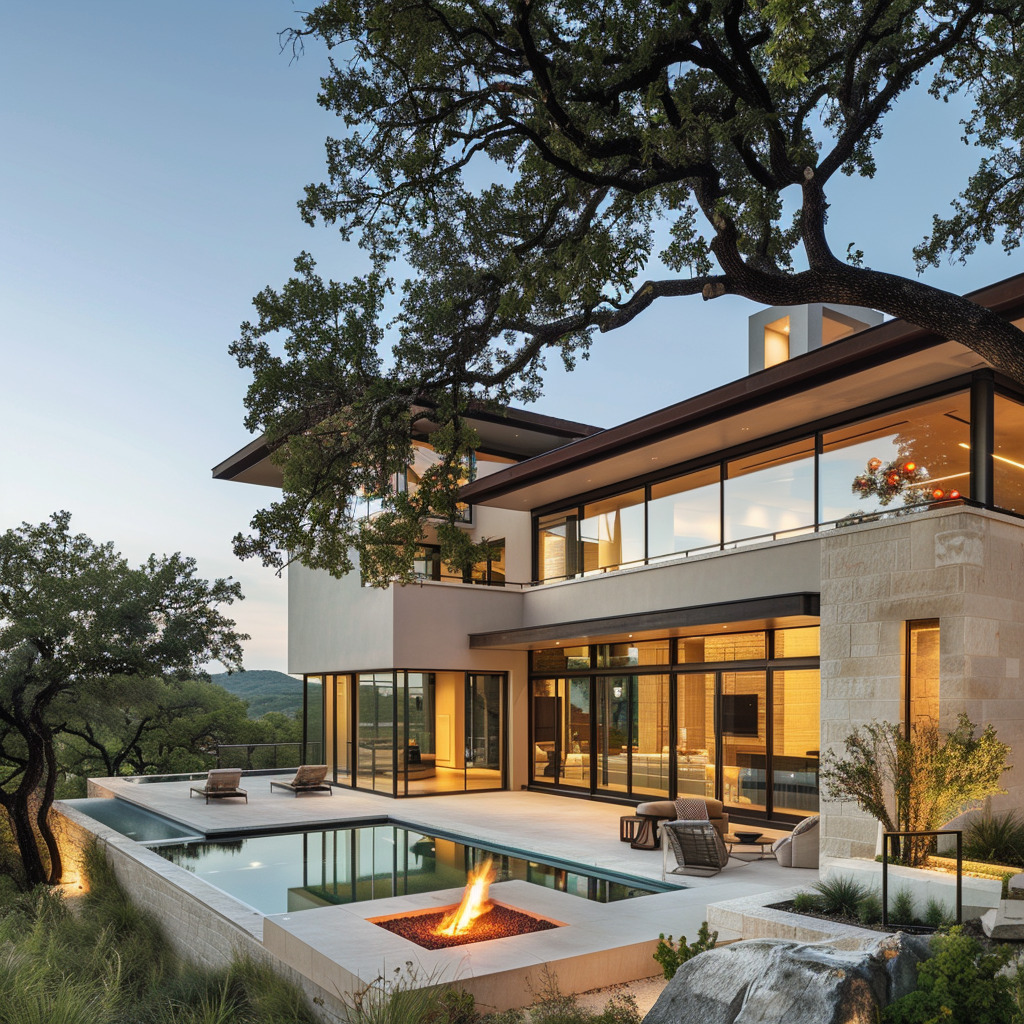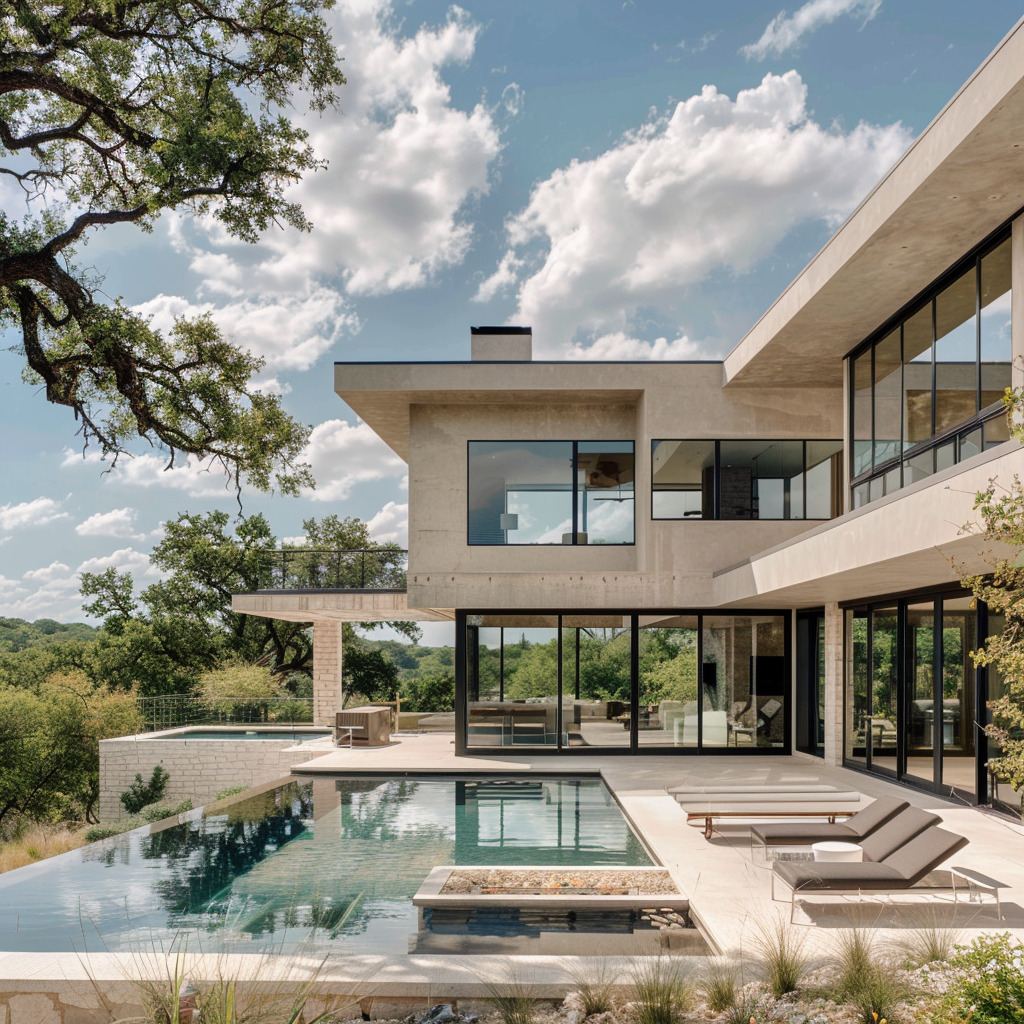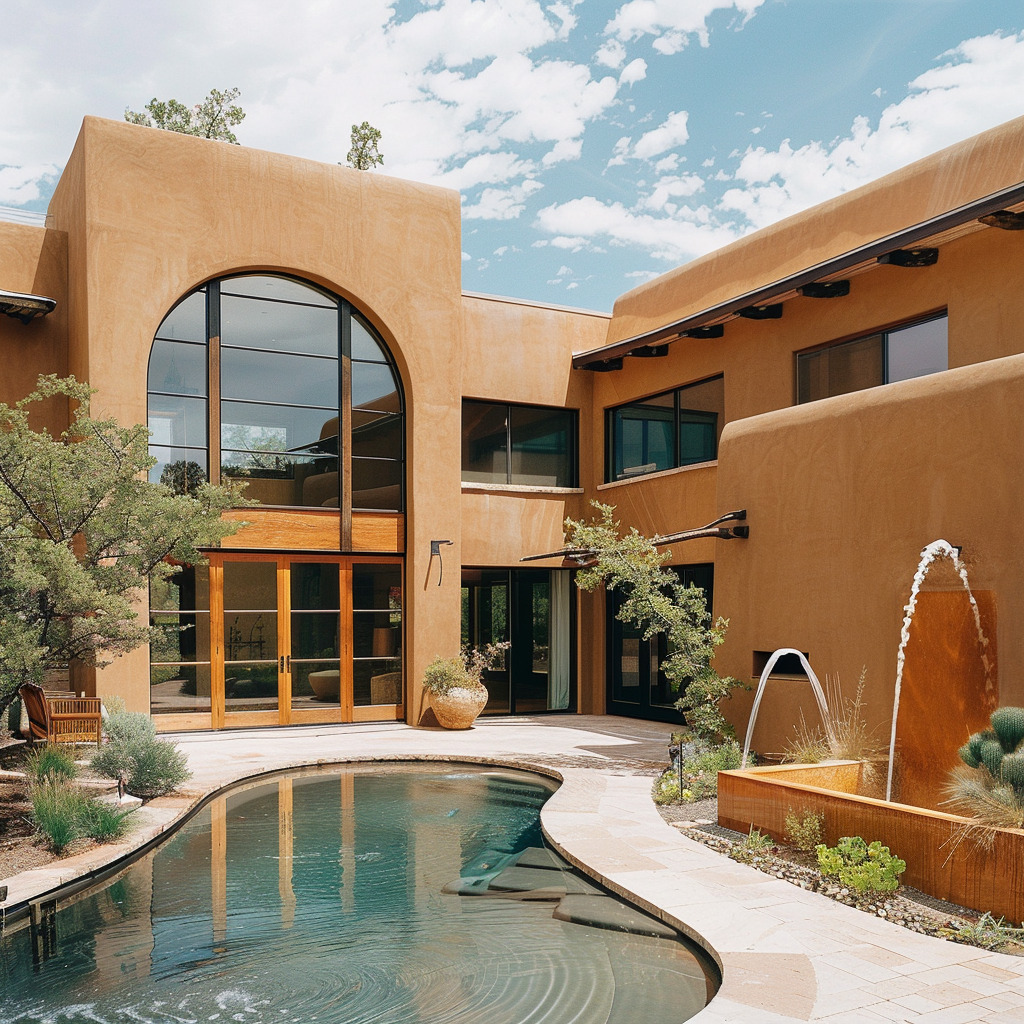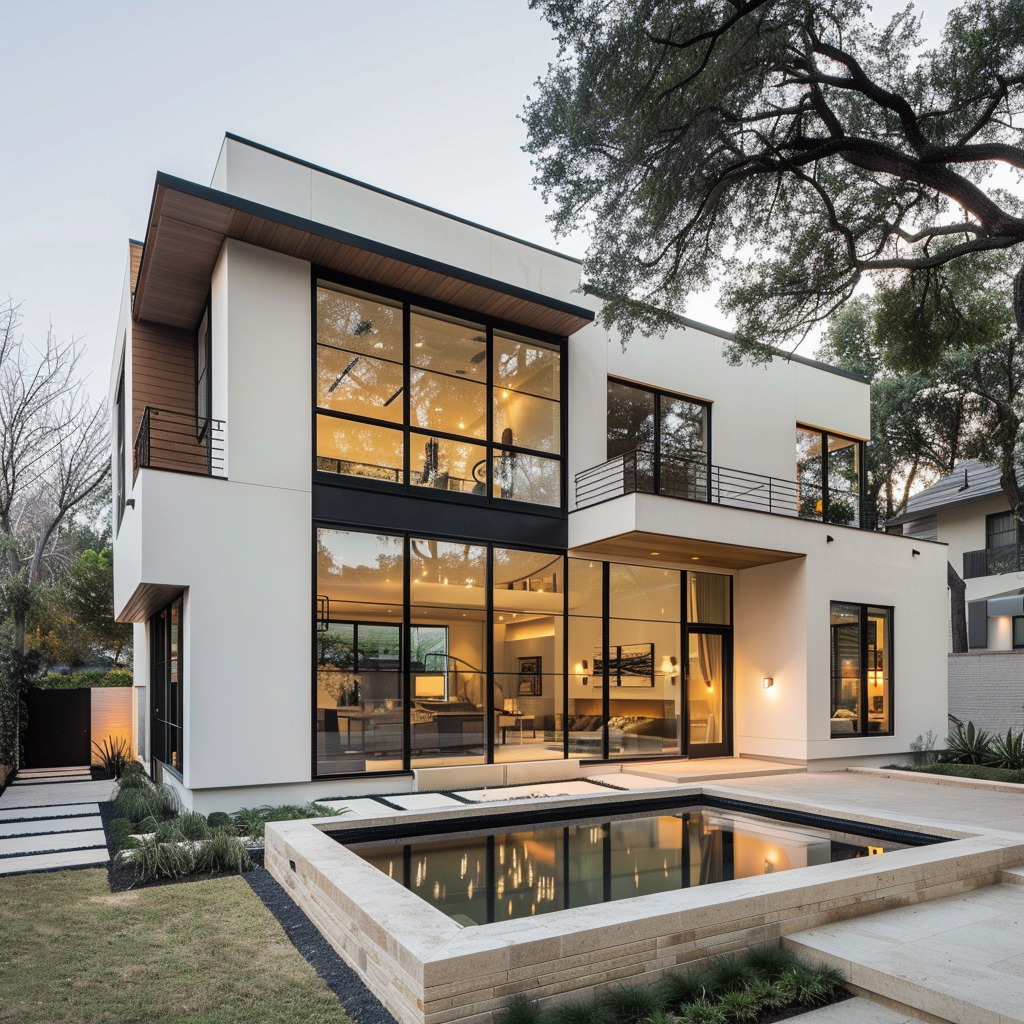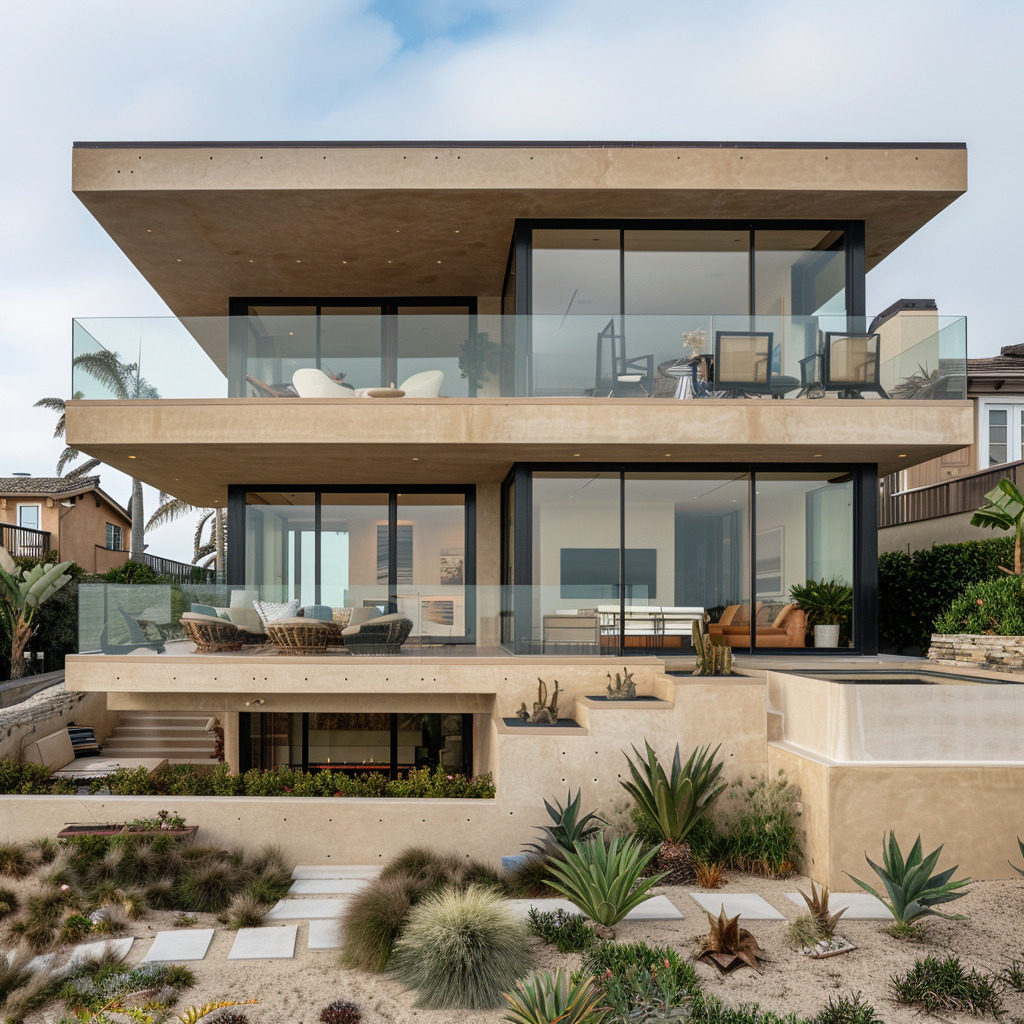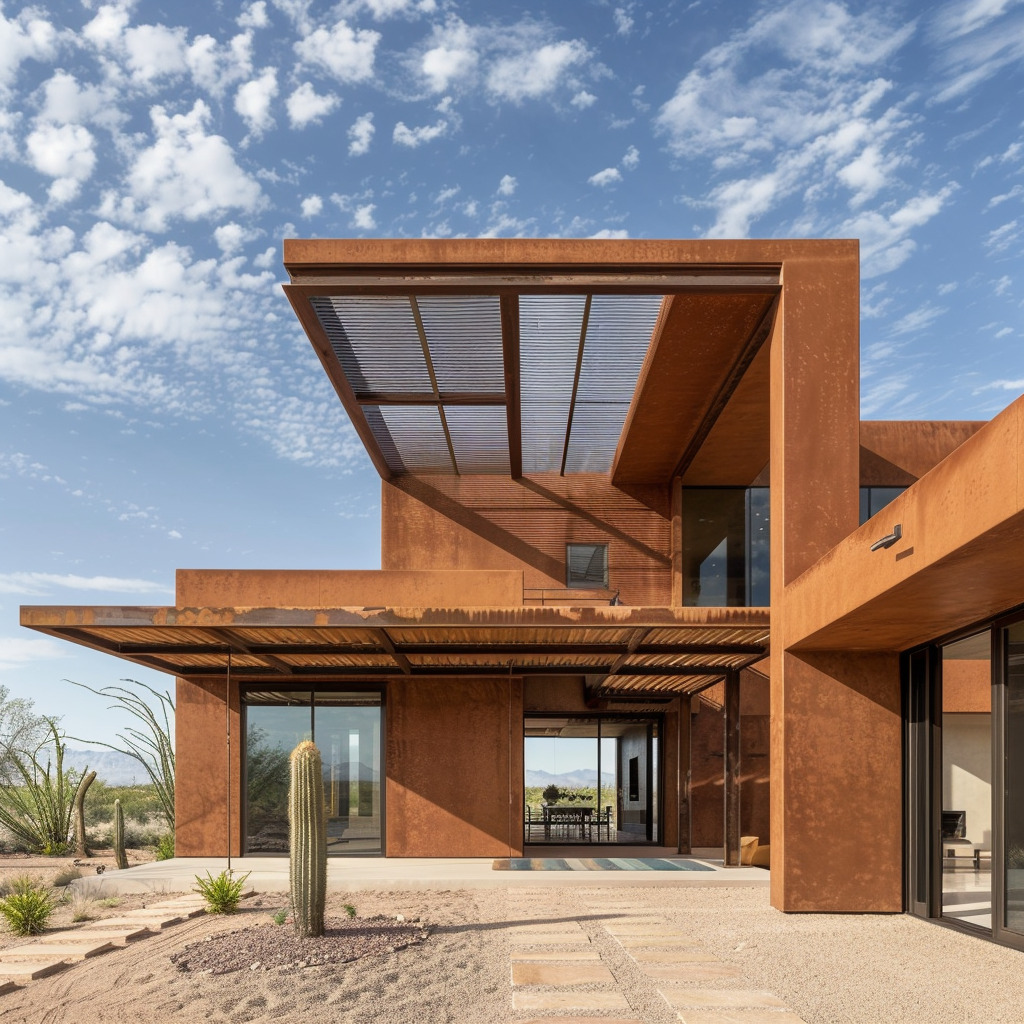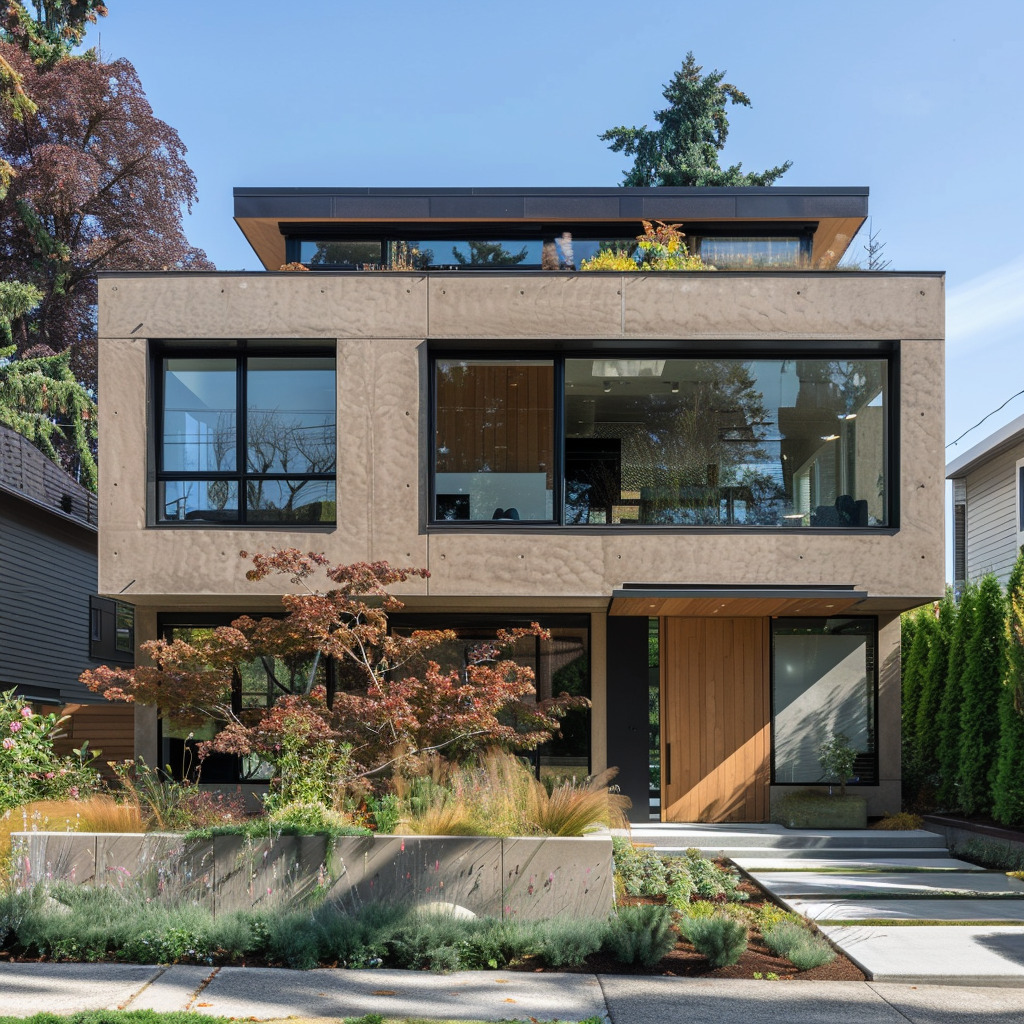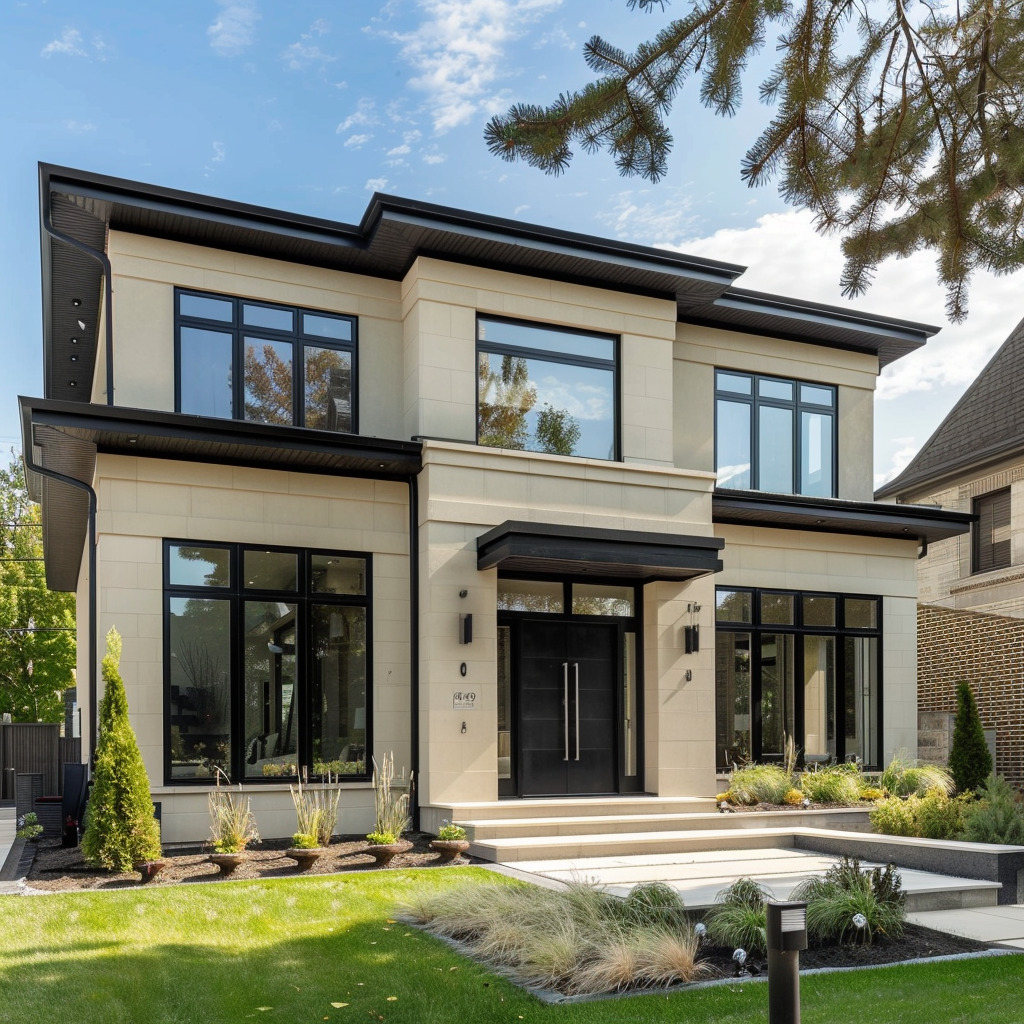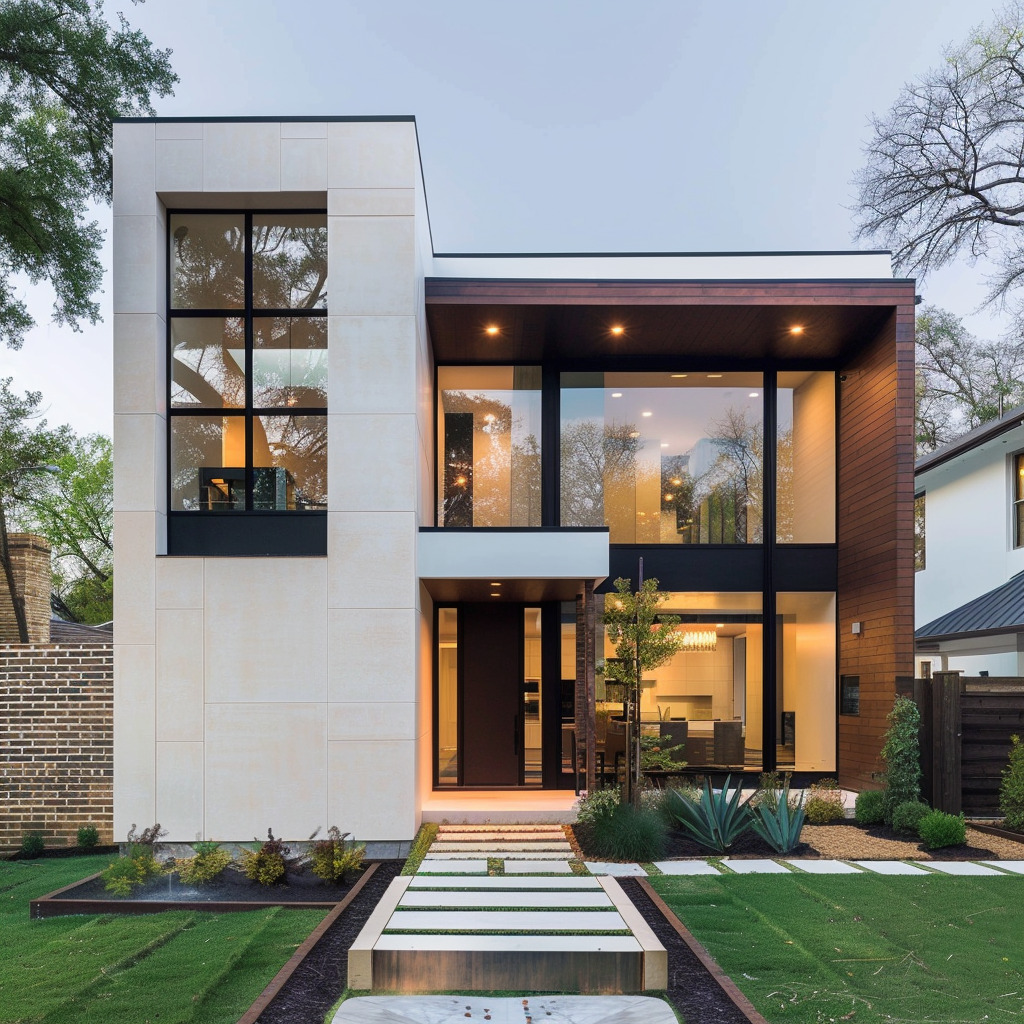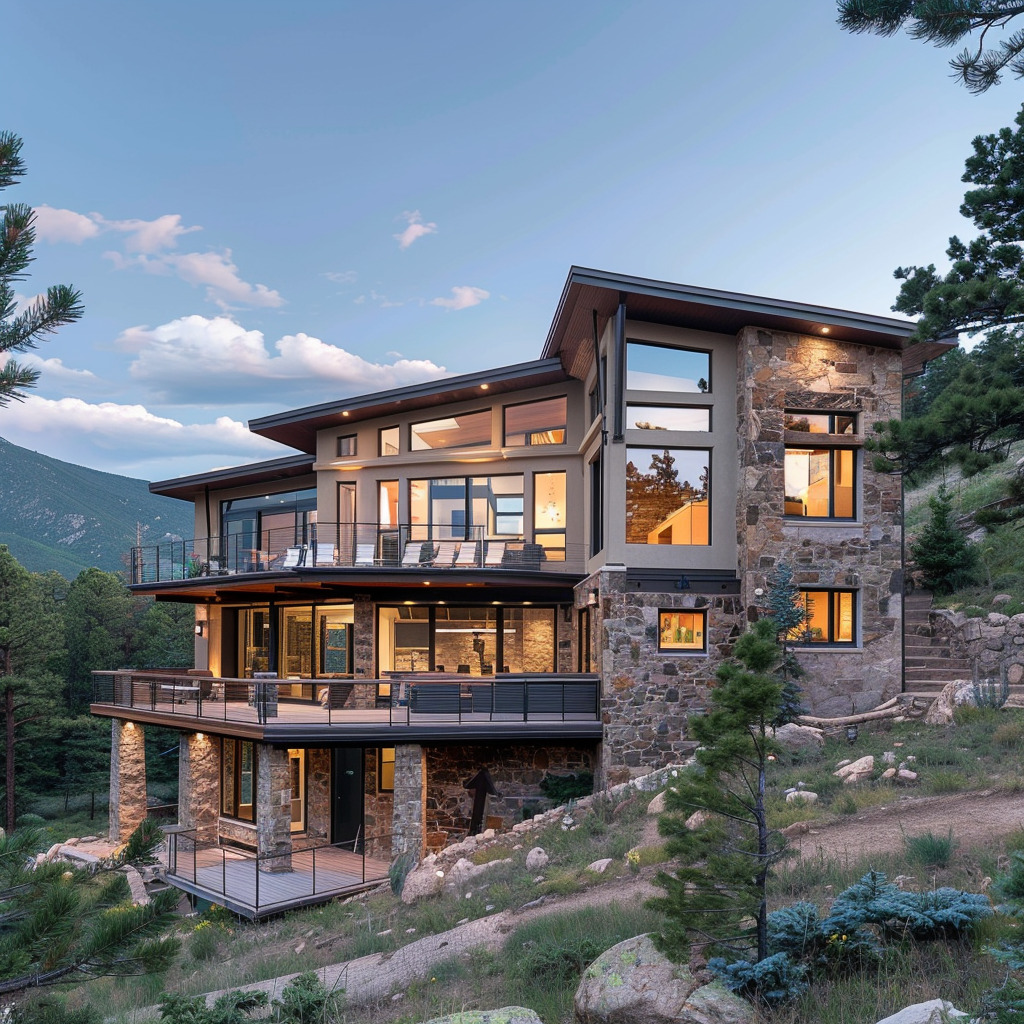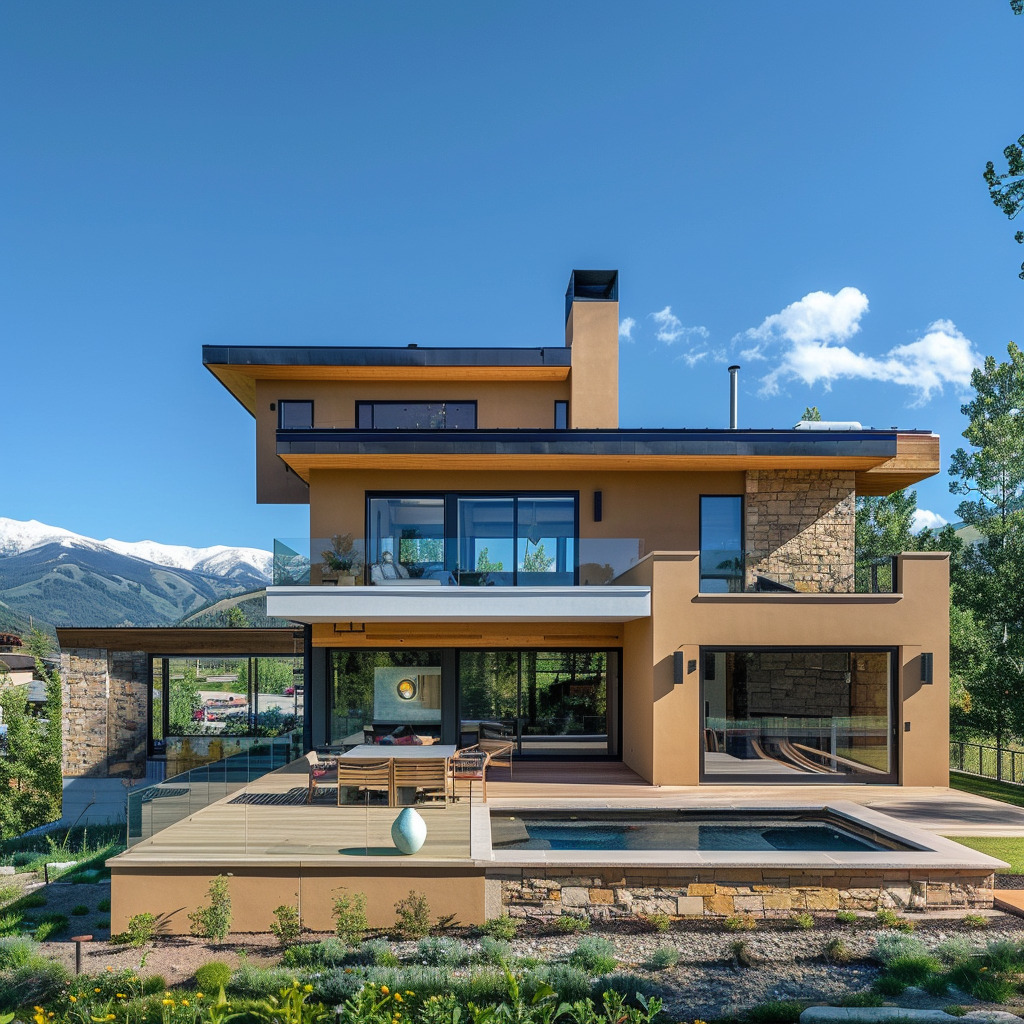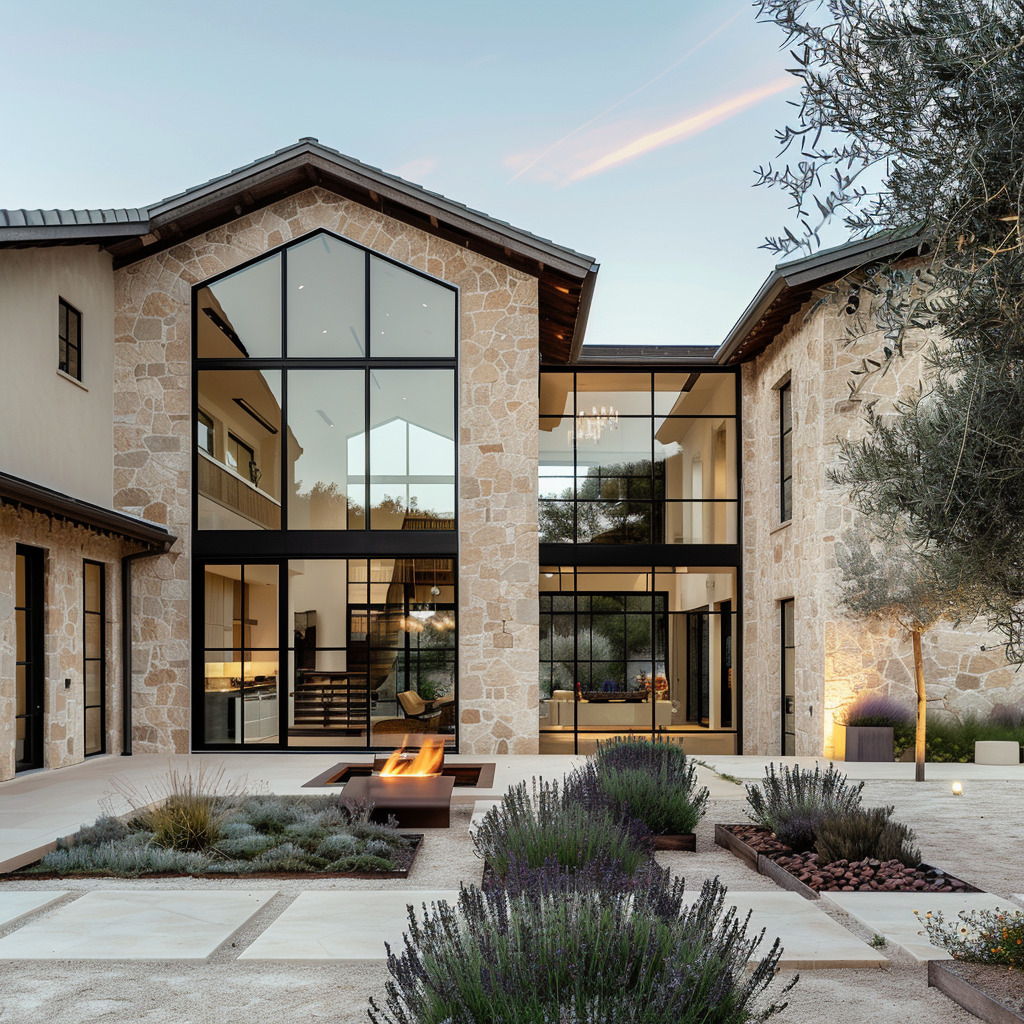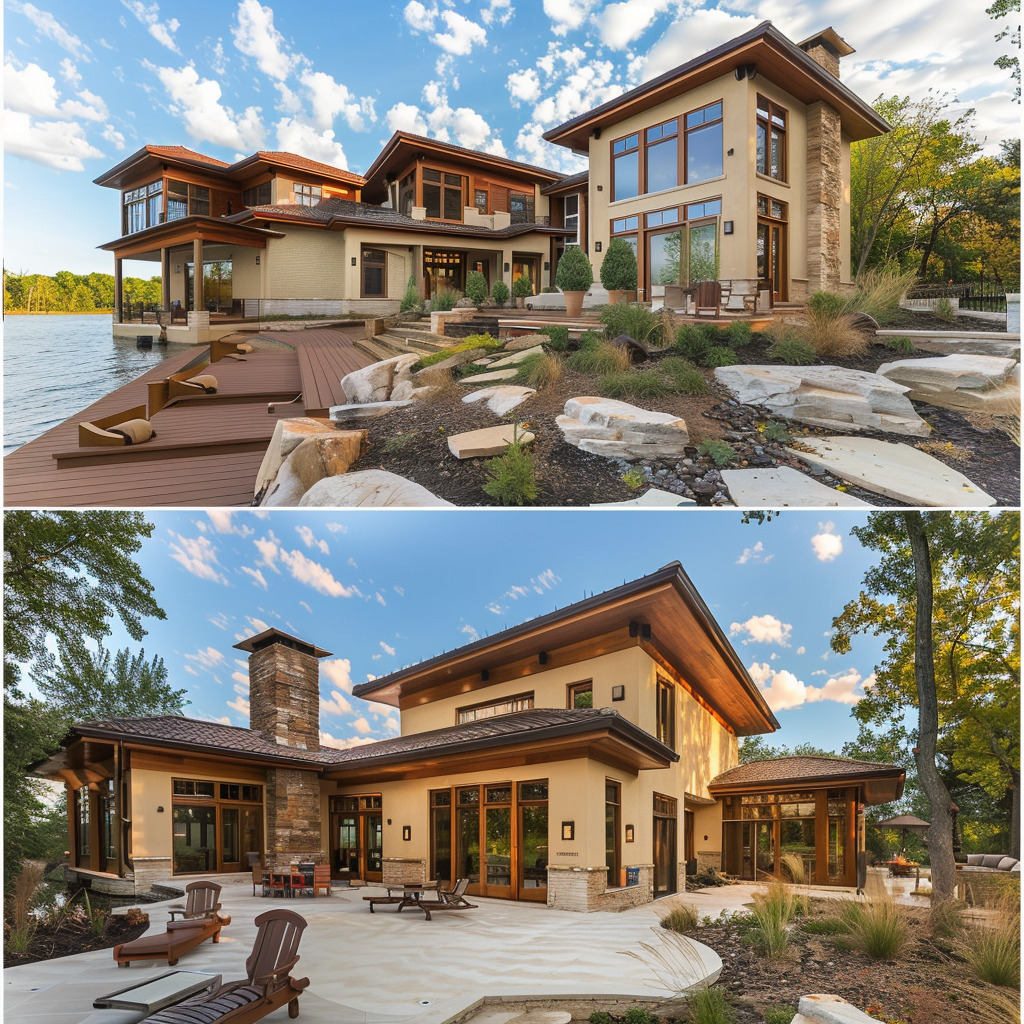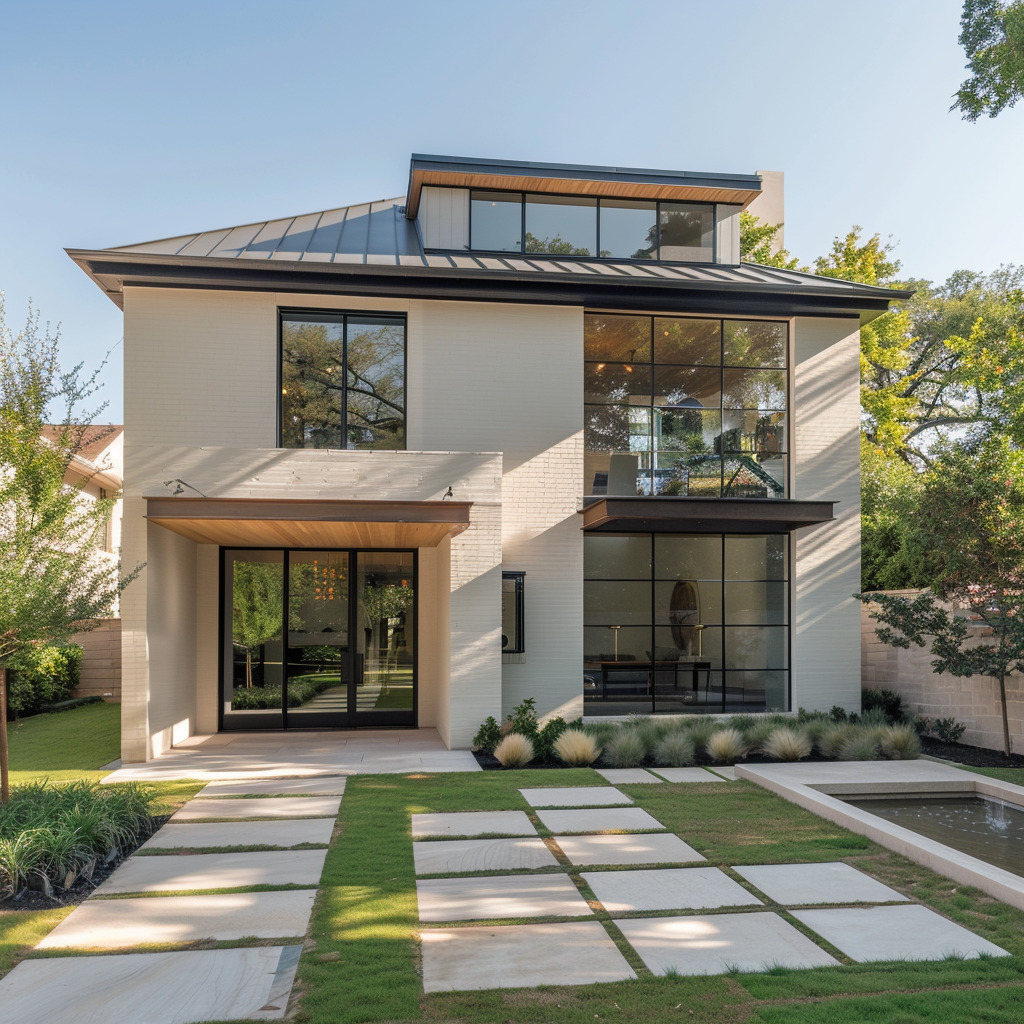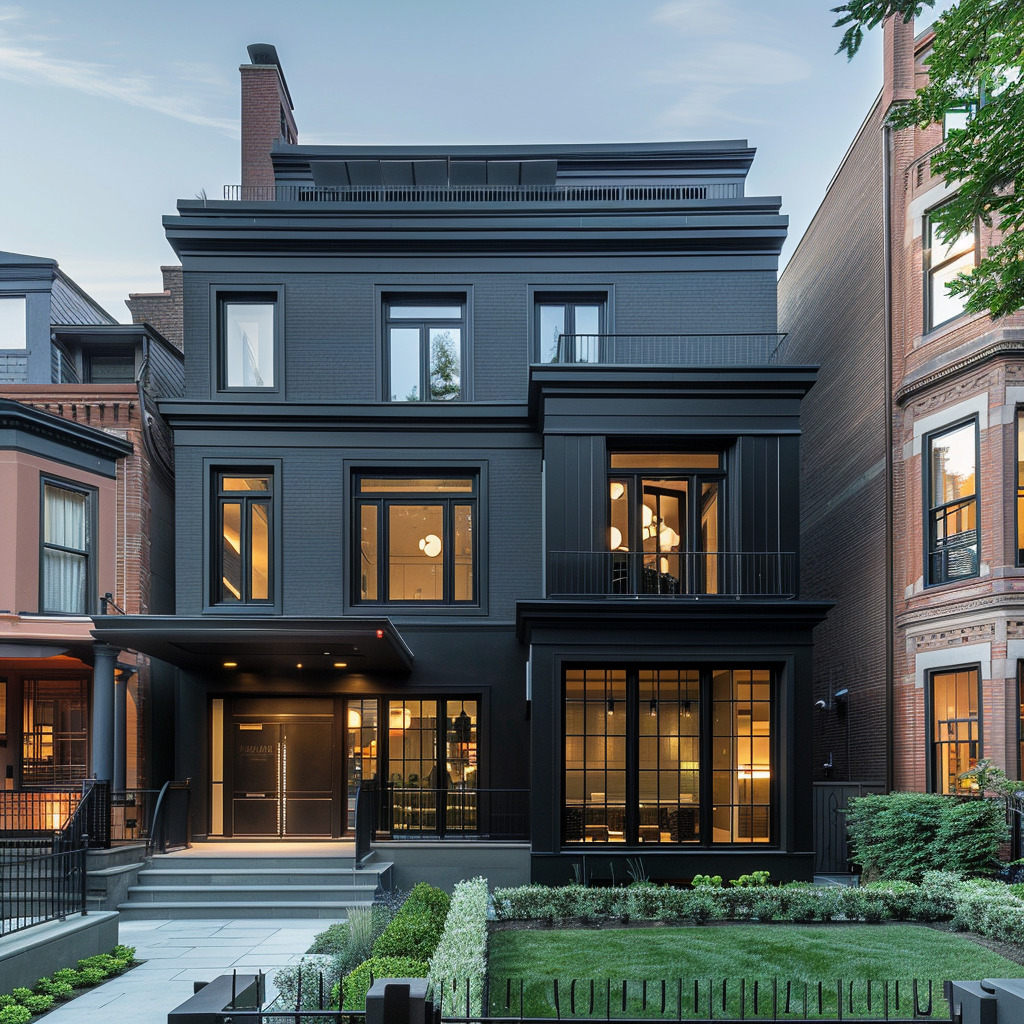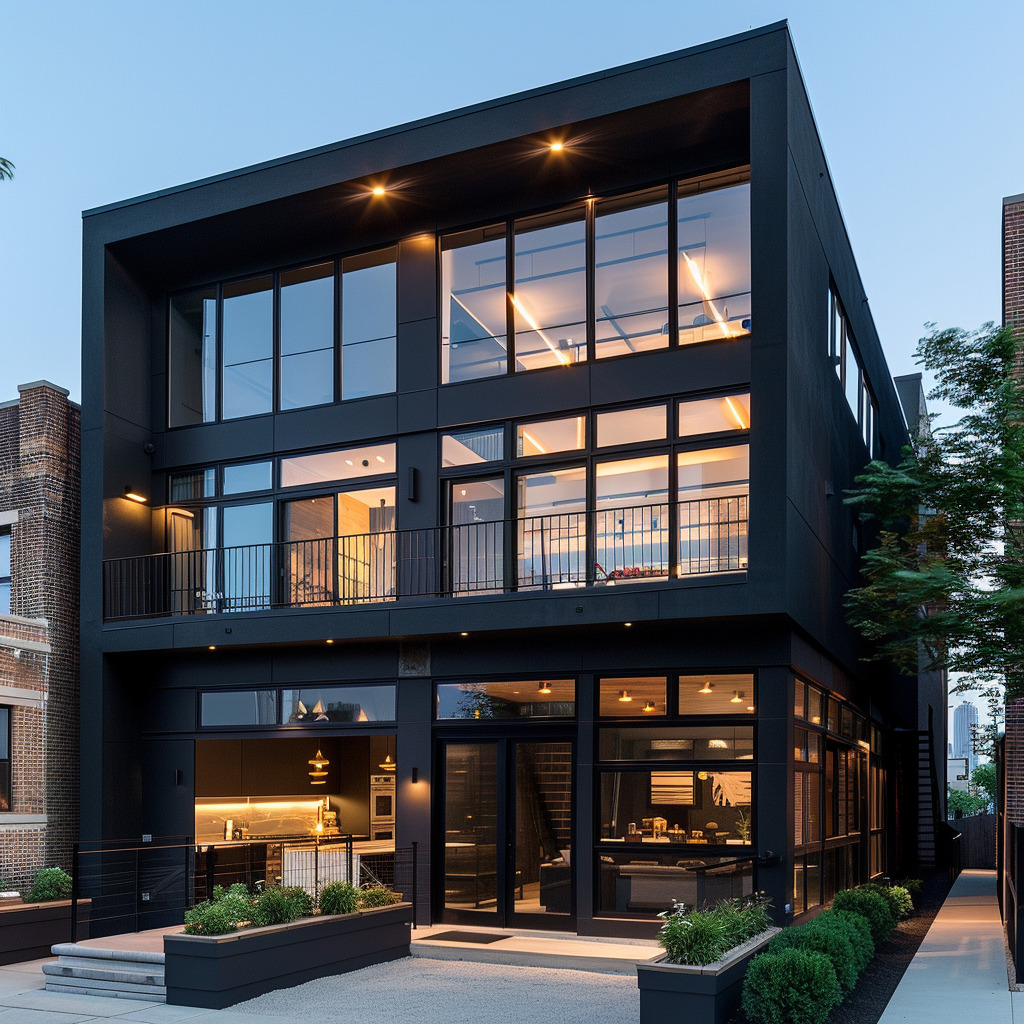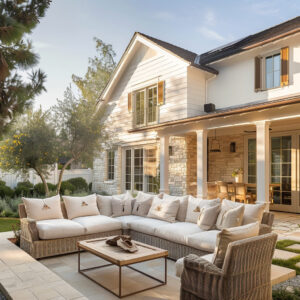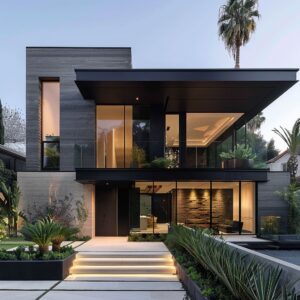Blending modern and rustic styles in home design creates a unique and appealing aesthetic that balances sleek, contemporary elements with the warmth and character of traditional materials. This approach is gaining popularity among homeowners who seek to combine the clean lines and open spaces of modern design with the inviting, natural textures of rustic decor.
Stucco is a versatile material that plays a crucial role in bridging the gap between modern and rustic aesthetics. Known for its durability and adaptability, stucco can be applied in various textures and colors, making it an ideal choice for achieving this blend.
It offers a smooth finish that aligns with modern design principles while its earthy appearance connects to rustic elements, making it a perfect unifying material.
Open-plan modern homes, characterized by large, interconnected spaces without the barriers of walls and doors, benefit significantly from the use of stucco. The continuous flow of stucco surfaces enhances the sense of spaciousness and cohesion, providing a unified look that complements the open-plan layout.
This design promotes a more social and flexible living environment, allowing for easy interaction and movement throughout the space.
The Facade: Harmonizing Modern and Rustic Elements
Stucco as a Primary Material:
Stucco is renowned for its versatile texture and wide range of color options, making it a favored choice for blending modern and rustic styles. It can be applied in smooth, polished finishes that complement contemporary designs or in rough, textured patterns that evoke a more traditional, rustic feel.
The color palette of stucco ranges from warm earth tones to cool neutrals, allowing it to harmonize with various architectural elements. The benefits of using stucco in home design extend beyond its aesthetic appeal.
Stucco provides excellent insulation, durability, and resistance to weather, making it a practical choice for both exterior and interior surfaces. In the context of blending modern and rustic styles, stucco’s ability to offer a seamless finish is particularly valuable.
It bridges the sleekness of modern design with the charm of rustic textures, creating a cohesive and balanced look.
Combining Stucco with Natural Materials:
To enhance the rustic appeal, stone accents are often integrated with stucco surfaces. Stone adds texture and depth, complementing the smoothness of stucco and providing a tactile contrast that enriches the overall design.
Stone can be used for feature walls, foundation elements, or decorative accents, contributing to the rustic character while maintaining a modern aesthetic. Incorporating wood elements further enhances the warmth and contrast in the design.
Wooden beams, trims, and exterior cladding add natural richness and depth, creating a welcoming and harmonious environment. The natural grain and color of wood juxtaposed with the clean stucco finish create a visually appealing interplay of materials that defines the blend of modern and rustic styles.
Contrasting Colors and Textures:
Utilizing a palette of neutral stucco tones combined with darker metal and wood elements adds visual interest and depth to the facade. Neutral colors provide a timeless and elegant backdrop that highlights the architectural features of the home.
When paired with darker materials, such as metal window frames or wooden beams, these neutral tones create a striking contrast that enhances the visual dynamics of the design. The interplay of different textures also contributes to the overall aesthetic.
The smoothness of stucco contrasts with the rough texture of stone and the natural grain of wood, creating a rich and layered look. This combination of textures and colors not only defines the architectural style but also adds character and warmth to the home, making it both contemporary and inviting.
Architectural Features and Design Principles
Roof and Overhangs
The roof design is a critical element in blending modern and rustic styles. Utilizing flat and angled roof sections creates a sleek, contemporary profile that complements the overall architectural theme.
The clean lines of a flat roof provide a minimalist look, while angled sections can add visual interest and address practical concerns such as water runoff and snow shedding. Deep overhangs are both functional and aesthetically pleasing.
They provide shade, reducing heat gain and improving energy efficiency, especially important in areas with intense sunlight. These overhangs also protect the walls and windows from weathering, extending the lifespan of the exterior materials.
Aesthetically, they contribute to the house’s profile, creating dramatic shadows and enhancing the visual depth of the facade.
Expansive Windows and Doors
Floor-to-ceiling glass walls are a hallmark of modern home design. They flood interiors with natural light, creating bright, airy spaces that feel connected to the outdoors.
This openness is essential for modern homes, making spaces feel larger and more inviting. The use of expansive glass also allows for unobstructed views of the surrounding landscape, integrating the beauty of nature into the living environment.
Sliding glass doors further enhance this connection by providing seamless transitions between indoor and outdoor spaces. They are practical for easy access to patios, decks, and gardens, encouraging outdoor living.
These doors are designed to disappear into the walls when open, maximizing the opening and blending the boundaries between inside and outside.
Balconies and Railings
Balconies extend the living space and provide private outdoor areas that are both functional and enjoyable. The use of glass railings on these balconies maintains open views and supports the modern aesthetic.
Unlike traditional railings, glass does not block sightlines, allowing uninterrupted vistas of the surrounding scenery. This choice of material ensures that the visual flow of the exterior remains clean and modern.
Designing balconies to be integrated with the overall architecture helps in creating a cohesive look. They serve as extensions of indoor spaces, offering additional seating or entertainment areas.
By aligning the balcony design with the main structure’s lines and materials, the result is a seamless and harmonious appearance.
Indoor-Outdoor Integration
Creating Seamless Transitions
Seamless transitions between indoor and outdoor spaces are essential in modern home design. Sliding glass doors and large windows play a pivotal role in achieving this.
They allow for fluid movement between the two environments, making it easy to move from inside to outside without barriers. This integration fosters a lifestyle that embraces outdoor living, perfect for entertaining or simply enjoying nature.
Large windows not only connect visually but also enhance ventilation and natural light, contributing to a healthier living environment. They blur the lines between indoors and outdoors, making the exterior spaces feel like an extension of the home.
Outdoor Living Spaces
Designing functional and luxurious outdoor areas is a key trend in modern home architecture. Patios, decks, and pools are essential features that extend the living space and offer areas for relaxation and entertainment.
These spaces are designed with comfort and functionality in mind, often equipped with outdoor furniture, dining areas, and shade structures to make them usable throughout the year. Sunken seating areas are particularly popular for creating cozy, intimate spaces that are protected from wind and provide a unique design element.
Built-in features like fire pits add warmth and ambiance, making outdoor areas inviting even on cooler nights. These elements ensure that outdoor living spaces are not only beautiful but also practical and enjoyable.
Landscaping and Natural Harmony
Complementary Landscaping
Landscaping plays a crucial role in the overall design, enhancing the home’s aesthetic and environmental integration. Using native plants is a sustainable choice that supports local ecosystems and requires less maintenance and water.
These plants are naturally adapted to the local climate, ensuring they thrive with minimal intervention. Blending hardscape elements like stone pathways with the natural terrain creates a cohesive look that ties the house to its surroundings.
These pathways guide visitors through the landscape, adding functionality while maintaining the natural beauty of the site.
Sustainable Design Practices
Sustainable design is an important consideration in modern architecture. Features like passive solar heating, which uses the building’s design and materials to naturally collect and distribute solar energy, reduce reliance on artificial heating.
Large windows placed to capture winter sunlight can significantly warm interior spaces, while overhangs can block intense summer sun, keeping the home cool. Choosing materials that reflect and harmonize with the natural environment is essential.
Natural stone, wood, and stucco not only provide durability and aesthetic appeal but also ensure the home blends seamlessly with its surroundings. These materials age gracefully and require less maintenance, contributing to the home’s sustainability.
Interior Design: Open-Plan Living
High-Quality Materials
The choice of materials is crucial in defining the look and feel of open-plan living spaces. Polished stone floors are a popular option, offering both durability and a sleek, modern aesthetic.
These floors are easy to maintain and reflect light, enhancing the brightness of the interior. They also provide a neutral base that complements various design elements.
Wooden ceilings add warmth and a sense of natural beauty to the space. The rich textures and tones of wood contrast nicely with the polished stone, creating a balanced and inviting atmosphere.
Custom cabinetry, often crafted from high-quality wood or contemporary materials, contributes to the overall aesthetics while providing practical storage solutions. These elements ensure that the interior is not only visually appealing but also functional and long-lasting.
Modern Amenities and Fixtures
Incorporating modern amenities and fixtures is essential to the comfort and functionality of open-plan homes. State-of-the-art kitchen appliances streamline cooking and entertaining, making the kitchen a focal point of the home.
Sleek, integrated appliances maintain the clean lines of the design, while high-performance features enhance convenience. Bathroom fixtures follow a similar trend, with minimalist designs that prioritize both form and function.
Frameless glass showers, floating vanities, and contemporary lighting fixtures contribute to a spa-like experience. These modern elements are carefully selected to blend seamlessly with the overall design, ensuring a cohesive and stylish interior.
Open Concept Layout
The open-plan layout is central to modern living, offering numerous benefits in terms of space and light. This design eliminates unnecessary walls, creating a continuous flow between living, dining, and kitchen areas.
The result is a spacious, airy environment that encourages interaction and flexibility in how the space is used.
High ceilings amplify the sense of openness, making rooms feel larger and more inviting. They also provide an opportunity for dramatic architectural features, such as exposed beams or skylights.
Large windows are another critical element, maximizing natural light and connecting the interior with the outdoor landscape. These windows frame views, bring in sunlight, and enhance the overall ambiance of the home.
Case Studies and Examples
Mountain Modern Homes
A detailed example of a mountain modern home showcases the blend of modern and rustic styles with the use of stucco. Nestled in a mountainous setting, this home features a facade of smooth stucco complemented by natural stone accents and wooden elements.
The open-plan interior emphasizes high-quality materials, including polished stone floors and wooden ceilings, creating a harmonious and warm living environment. Expansive windows offer stunning views of the surrounding peaks, integrating the natural beauty into the home.
Desert Modern Homes
In the desert, a modern home uses weathered steel and stucco to blend with its arid environment. The weathered steel provides a rugged, earthy texture that complements the smooth, neutral-toned stucco.
This combination creates a striking yet cohesive exterior. Inside, the open-plan layout is enhanced by floor-to-ceiling windows that flood the space with light and offer expansive desert views.
Outdoor living areas are designed to be extensions of the indoor spaces, with shaded patios and sunken seating areas providing comfort and functionality.
Coastal Modern Homes
A coastal villa exemplifies the harmonious design achieved with white stucco and wood. The white stucco exterior reflects the bright coastal light, while wooden accents add warmth and texture.
The open-plan interior features polished stone floors and large windows that frame ocean views, creating a serene and luxurious living space. Outdoor terraces and balconies are seamlessly integrated, providing ample space for relaxation and entertaining while enjoying the coastal breeze.
Conclusion
In conclusion, blending modern and rustic styles with stucco creates a unique and appealing aesthetic for open-plan homes. The thoughtful use of materials like stucco, stone, and wood, combined with modern design principles, results in spaces that are both beautiful and functional.
This approach enhances the quality of living by creating harmonious, inviting environments that connect with their natural surroundings.
The importance of design and material choice cannot be overstated in achieving this balance. By exploring these principles, homeowners can create personalized spaces that reflect their style and embrace the best of both modern and rustic elements.
Whether situated in the mountains, desert, or by the coast, these homes offer a timeless appeal and a truly unique living experience.

